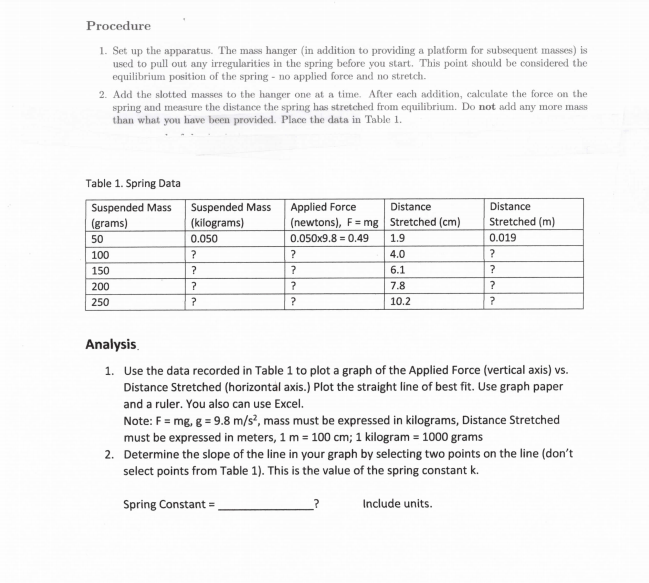Procedure 1. Set up the apparatus. The mass hanger (in addition to providing a platform for subsequent masses) is used to pull out any irregularities in the spring before you start. This point should be considered the equilibrium position of the spring - no applied force and no stretch. 2. Add the slotted masses to the hanger one at a time. After each addition, calculate the force on the spring and measure the distance the spring has stretched from equilibrium. Do not add any more mass than what you have been provided. Place the data in Table 1. Table 1. Spring Data Suspended Mass Suspended Mass (grams) Applied Force Distance Distance |(kilograms) (newtons), F = mg Stretched (cm) Stretched (m) 50 0.050 0.050x9.8 = 0.49 1.9 0.019 100 ? 4.0 150 6.1 200 7.8 250 ? 10.2 Analysis. 1. Use the data recorded in Table 1 to plot a graph of the Applied Force (vertical axis) vs. Distance Stretched (horizontal axis.) Plot the straight line of best fit. Use graph paper and a ruler. You also can use Excel. Note: F = mg, g = 9.8 m/s², mass must be expressed in kilograms, Distance Stretched must be expressed in meters, 1 m = 100 cm; 1 kilogram = 1000 grams 2. Determine the slope of the line in your graph by selecting two points on the line (don't select points from Table 1). This is the value of the spring constant k. Spring Constant = Include units.
Simple harmonic motion
Simple harmonic motion is a type of periodic motion in which an object undergoes oscillatory motion. The restoring force exerted by the object exhibiting SHM is proportional to the displacement from the equilibrium position. The force is directed towards the mean position. We see many examples of SHM around us, common ones are the motion of a pendulum, spring and vibration of strings in musical instruments, and so on.
Simple Pendulum
A simple pendulum comprises a heavy mass (called bob) attached to one end of the weightless and flexible string.
Oscillation
In Physics, oscillation means a repetitive motion that happens in a variation with respect to time. There is usually a central value, where the object would be at rest. Additionally, there are two or more positions between which the repetitive motion takes place. In mathematics, oscillations can also be described as vibrations. The most common examples of oscillation that is seen in daily lives include the alternating current (AC) or the motion of a moving pendulum.

Trending now
This is a popular solution!
Step by step
Solved in 3 steps with 1 images









